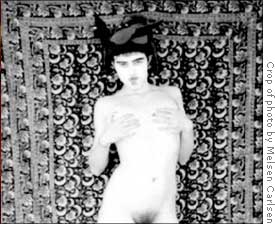
| << Front page | Arts | May 13, 2005 |
Embodiment in Fisher Hall
 |
||
| “Triptych” | ||
Melsen Carlsen is an art student gaining visibility at Oberlin College. His upcoming photography exhibit Seeking Embodiment deals with feelings of experiencing his own body as a mask, his realization of his transgender identity, his transition from female to male using testosterone injections and his family’s coping with this transition. Photographs of Carlsen’s process of understanding his own transgender identity along with documentary photographs of Carlsen’s family by artist Madeline de Sinety will be exhibited.
Melsen’s photographic work began at Oberlin in 2003 in Visual Processes: Photography with Professor Pipo Nguyen-Duy. His first piece, featured in the upcoming show, is entitled “Triptych” (2003). In the third photograph of this series, Melsen stands naked before the camera. His face is painted white. He paints black over his eyebrows and a false beard on his chin. His hands are covering his breasts in a pose that suggests femininity. However, the viewer is jarred by the face paint, which suggests that Melsen is a circus or theatrical performer. Melsen states that the mask “shows how I feel on the inside” — uncomfortable in his body. This photograph was taken when Melsen still identified himself as Melissa, had not started taking testosterone supplements, and had not visibly called his gender into question.
“The Two Melsens” (2000), was made after Melsen began to publicly identify himself as transgendered. This photograph, modeled on Frida Kahlo’s “The Two Fridas” (1939), shows Melsen in feminine and masculine gender constructions. On the left, the viewer sees a feminine Melsen wearing a long blue dress. While the dress is marked as feminine, Melsen’s legs are positioned in a way suggesting he is uncomfortable in his given body. The brightness of his red lipstick indicates an exaggerated femininity contrasted with his short masculine hair. In his right hand, the viewer sees a syringe of testosterone. His feminine left hand is holding the hand of another, more masculine-looking version of himself. In this more masculine version, the viewer sees that the white face paint from the previous print has been removed, leaving only a small beard. The photograph suggests that an intense dialog is taking place between the masculine and the feminine Melsens.
Melsen’s third piece, “Phallus Play” (2005), opens a dialogue regarding the significance of the penis. This piece poses many questions: Why does Melsen need a penis? What makes a man? Is he a man if he appropriates a penis? Finally, why is the penis given so much importance? Melsen poses himself as a model, putting on an object that isn’t inherently part of him. The penis is exposed as a tool and a fashion statement in this piece, and the new part does not necessarily define Melsen as a person. These photographs flesh out the complex experience of embodiment.
The artist Madeleine de Sinety has been documenting Melsen’s
transition. Seven of de Sinety’s heart-wrenching personal photographs of
Melsen and his family are included in the exhibit. Melsen’s show opens on
Wednesday, May 18 at 8 p.m. in Fisher Hall.
About us
Subscriptions
Advertising